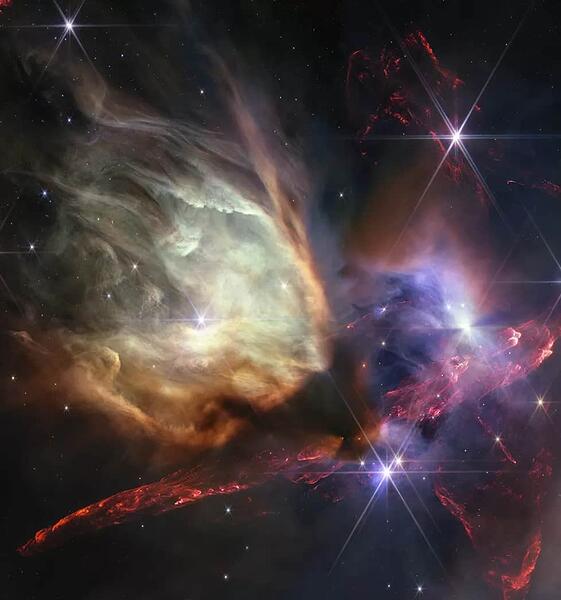Just came across a really good explanation about the L2 Lagrange points in space and how the James Webb space craft will actually be kept slightly inside the L2 point so that it doesn’t get lost for ever. Quite fascinating.
NASA has published the first pictures from James Webb
If that doesn’t get your juices flowing nothing will
omg wot a crap awful production so 1. you expect us to listen to that and 2, understand it ?? - forget it man you are all jumping the gun - why don’t you wait until it is functioning well??
Another fascinating piece about the James Webb Telescope.
They have identified the image from each mirror and are preparing to align. Really interesting, really worth watching.
The telescope even takes a picture of the mirrors, definitely a must watch video.
The Telescope mirrors have been aligned completing two of the three steps getting the telescope focused.
- oh my word! This is so exciting. I adore Space photos

I know why the sky is so high! It is so birds don’t bump thneir heads
I couldn’t understand a word of the article, but enjoyed seeing the images.
There is a resident nearby who loves to fuss Holly (and she loves him), and it was he who talked about this telescope, and the images it had delivered. He loves to watch the ISS, as do I.
I don’t understand about it at all, its way above my head
It certainly is that! 
Thats fabulous…I’ve seen these telescopes and they are amazing. I have been to the local Observatory and watched the night sky…its fascinating ![]()
The main mirror on this telescope has already been damaged by micrometeoroid strikes.
Well after all the money thrown at this, surely they would have put something in place to stop this? If this happens a lot over time, what a waste 
From what I’ve heard and read about this space telescope, this sort of damage was to be expected and the whole shebang only has an expected working life of 5yrs or so. Because of its size, the designers, engineers, technicians and constructors couldn’t find a way of protecting the mirror from “space dust”.
Well this surprises me to be honest! For the amount of money slapped all over it, you would think protecting it would be a top priority!
The only thing they could reasonably protect is all the electronics with that great big sail thing that stops direct sunlight from damaging the important bits. Even the sail has a limited life expectancy because of the sun’s emissions.
Spectacularly breathtaking. 
Looking back into the history of everything.
The team’s contention is that the sparkles are globular clusters just like the globulars seen around our Milky Way today, except we’re seeing these dots much, much earlier in the history of the Universe.
We see the Sparkler as it was nine billion years in the past, or about 4.5 billion years after the Big Bang.
“We are finding these globular clusters to be very massive,” explained Dr Lamiya Mowla from Toronto’s Dunlap Institute for Astronomy & Astrophysics. "We also find them to be very old.
“They could have formed in a burst at what we call ‘cosmic noon’, at the peak of star formation at about 10 billion years ago. But their colour isn’t right. For something to be relatively young, it has to be bluer, and what we’re finding is that they’re much redder than we expected them to be, which means they must be older, even at that very early time,” she told BBC News.
The team contends the stars in these globular sparkles probably formed just a few hundred million years after the Big Bang. It’s even possible, the astronomers say, that the sparkles contain some of the very first stars ever to form in the Universe.
“They’re the Holy Grail, right?” said Dr Mowla.
Guess Nasa would say, ‘We’re working on it.’ 

Nasa has just released a spectacular image of one of the most photographed parts of the sky. It’s the Rho Ophiuchi cloud complex, which is the nearest star-forming region in space to us, being just 400 light-years away.
What Webb shows us is only a tiny part of this dense region of gas and dust, which is what you’d expect, given the telescope’s astonishing resolution. The entire image is about half a light-year across, or 4.7tn km.
The eye is immediately drawn to the white nebula at centre-left where a relatively young - a few million years old - star called S1 is lighting up everything around it. But look below at the red, bar-like feature that stretches across the entire image. This is an outflow of material from a protostar called VLA1623.
Very young stars - their age measured in mere thousands of years - will pull hydrogen gas and dust on to themselves as they grow. But the dynamics involved mean some of this material will also get ejected outwards to crash into, and light up, the nearby environment.
VLA1623 is one such nascent star. It’s buried deep within the outflow and is invisible to Webb’s infrared eyes. We know it’s there, however, because telescopes sensitive at radio wavelengths have seen it. They’ve also detected two or three other similar protostars in the immediate vicinity that are likely contributing to the outflow’s contortions.
Once you realise what’s going on in the image around VLA1623, you can then pick out similar flows elsewhere in the Webb vista. There are a great many, which just illustrates how productive this region of space is.
Fascinating … ![]()






